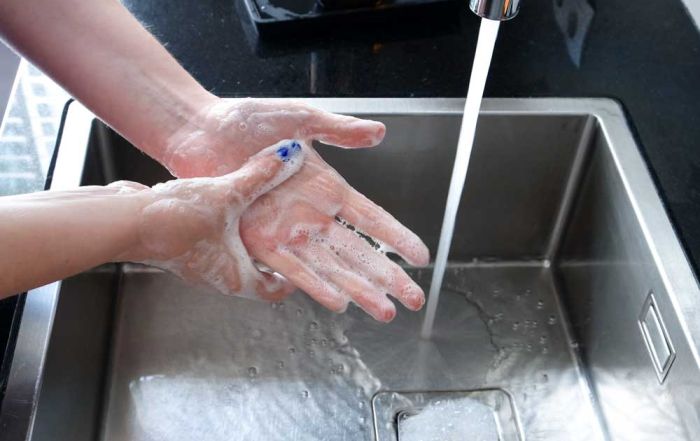Hand sinks: Often Taken for Granted, but an Essential Part to Effective Hand Hygiene
Late in January, I received a question about hand sinks in a foodservice operation. The question pertained to school staff (teachers and aides) who were using a hand washing sink in the school kitchen. The question came as a matter of who was allowed access to the kitchen to use the sink, but the question itself caused me to go down a rabbit hole of requirements for hand washing sinks in foodservice operations.
Hand sinks are, perhaps, taken for granted by many managers, supervisors, and employees in foodservice operations when it comes to reviewing hand washing effectiveness. They are easy to take for granted, until they are not working. Even in these blogs, we’ve focused on the correct procedure for washing your hands, when to wash hands, and hand washing supplies, but we don’t often focus on the hand sink.
The FDA Model Food Code states at least one hand sink should be available to employees. Further recommendations are that the sink should be convenient for employees who participate in food preparation, dispensing, and ware washing and there should be a hand sink immediately adjacent to restrooms.
…employees are more likely to wash their hands if the operation has more than one handwashing sink and/or a sink is located within the sight of the employee.
Our previous research has found that one big barrier to employees washing their hands is how convenient the sink is to their work area. Remember that your definition of convenient and your employees may very well differ. I once had one of my employees tell me that he can’t wash his hands as many times as he would need to by “the code”, simply because it takes too much time, and we expected him to get food out to our guests in a timely manner. Even though our management team thought that both hand washing sinks in the kitchen were convenient for all of our employees, employee perception didn’t agree – and it was the employees’ perception that really mattered as they were the ones working in that area 40 hours a week.
Other research in the field has also found employees are more likely to wash their hands if the operation has more than one hand washing sink and/or a sink is located within the sight of the employee. So how many is enough in your operation? The food code doesn’t give a straight answer to that question because it really does depend on your business. For a small-scale, limited production kitchen, one sink may very well be enough. However, for larger operations with complex food production, many sinks would be desired and recommended.
Solid recommendations on the number of sinks required are difficult to come by. Foodservice Equipment and Supplies Magazine noted that you should allow one hand sink for every five employees working in your kitchen at a time. Further, they noted that one hand sink should be planned for every 300 square feet of kitchen space, and one hand sink for each foodservice preparation and/or cooking area. These recommendations align with research in the area and would certainly mean that the hand washing sink is convenient and in view of each employee in the production area.
While this is great information to have, many who are reading this are likely dealing with kitchens that are already built and unable to easily renovate spaces to accommodate more hand washing sinks. In this case, it is imperative that we try to reinforce the importance of hand washing with our employees and remove any barriers they may have to washing their hands. Only then will employees start to change their behaviors and improve hand washing compliance.
Later this month, be on the lookout for the SafeBites Webinar Series announcements for 2023. We have an exciting set of webinars that we are planning this year. In the meantime, if you have any food safety questions, we are a quick email away and would be happy to assist. Risk Nothing.
READ MORE POSTS
30 Years Later: The Foodborne Illness Outbreak that Changed Food Safety
In January, we hit a major anniversary. One I am betting snuck by many of you – including me! January marked 30 years since the deadly 1993 E. coli O157:H7 outbreak at Jack in the Box restaurants on the west coast. The anniversary wasn’t on any of the major news networks that I recall. It did make it into a few newspapers, at least one or two of the newspapers that are left. It wasn’t until late-February that I realized it.
Does Temperature Really Matter when Washing your Hands?
In January, I reviewed the changes to the 2022 Food Code in my blog (check out Part I and Part II), and one change to the food code that I had mentioned, but didn’t discuss in-depth, was the change that lowered the water temperature a hand sink was required to produce to 85°F, as noted in Section 2-202.12 of the code. This requirement has been in place since the publishing of the 2001 Food Code, which required a water temperature of 100°F. Prior to this, 110°F was required (see the 1999 Food Code). So why the change and does water temperature when washing your hands really matter?
Hand sinks: Often Taken for Granted, but an Essential Part to Effective Hand Hygiene
Late in January, I received a question about hand sinks in a foodservice operation. The question pertained to school staff (teachers and aides) who were using a hand washing sink in the school kitchen. The question came as a matter of who was allowed access to the kitchen to use the sink, but the question itself caused me to go down a rabbit hole of requirements for hand washing sinks in foodservice operations.
Hot off the Press: The 2022 Model Food Code has been Released! Part Two.
Earlier in the month, we started a discussion about the changes to the 2022 Food Code. If you missed that post, late in December 2022, the Food and Drug Administration released the 2022 Food Code and I wanted to highlight a few of the changes that have been made to the code.










